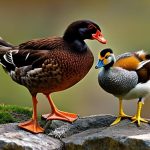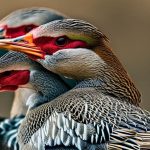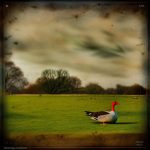Geese infestation is a common problem in many areas, causing damage to property and posing health risks. It is important to address this issue using humane and effective methods to ensure the well-being of both humans and geese. This article will provide a comprehensive guide on geese control, covering various methods and techniques that can be used to deter geese from unwanted areas.
Key Takeaways
- Canadian geese are attracted to open spaces near water and grassy areas.
- Physical barriers like fences and netting can prevent geese from entering certain areas.
- Natural repellents like grape extract and predator urine can deter geese from staying in an area.
- Sound and visual deterrents like decoys and lasers can scare geese away.
- Keeping the environment clean and unattractive to geese can discourage them from staying in an area.
Understanding the Behavior of Canadian Geese
Canadian geese are large waterfowl that are native to North America. They are known for their distinctive honking sound and V-shaped flight formation. Geese are attracted to certain areas for several reasons, including the availability of food, water, and shelter. They are particularly drawn to open spaces such as parks, golf courses, and residential areas with large lawns.
To effectively deter geese, it is important to understand their behavior. Geese are social animals that prefer to stay in groups, known as flocks. They are also territorial and will defend their nesting sites aggressively. Geese are herbivores and feed on grass, grains, and aquatic plants. They are attracted to areas with abundant food sources and open water.
Creating Physical Barriers to Deter Geese
One effective method of geese control is the use of physical barriers. There are several types of physical barriers that can be used, including fences, netting, and floating barriers. Fences can be installed around the perimeter of an area to prevent geese from entering. Netting can be used to cover ponds or other bodies of water to prevent geese from accessing them. Floating barriers can be placed in water bodies to create a physical barrier that prevents geese from landing.
Each type of physical barrier has its advantages and disadvantages. Fences are effective at keeping geese out but may not be aesthetically pleasing. Netting can be effective at preventing geese from accessing water bodies, but it may require regular maintenance to ensure it remains intact. Floating barriers are effective at preventing geese from landing on water bodies, but they may not be suitable for all types of water bodies.
When installing physical barriers, it is important to consider the height and strength of the barrier. Geese are capable of flying and can jump over low fences. The barrier should be tall enough to prevent geese from flying over it. It should also be strong enough to withstand the weight and pressure of geese attempting to break through.
Using Natural Repellents to Keep Geese Away
Another method of geese control is the use of natural repellents. There are several types of natural repellents that can be used, including taste repellents, scent repellents, and visual repellents. Taste repellents are substances that make the grass or other vegetation unpalatable to geese. Scent repellents are substances that emit a strong odor that repels geese. Visual repellents are objects or devices that create a visual deterrent for geese.
Each type of natural repellent has its advantages and disadvantages. Taste repellents are effective at deterring geese from feeding on grass or other vegetation, but they may need to be reapplied regularly. Scent repellents can be effective at repelling geese from an area, but they may not be suitable for all environments. Visual repellents can be effective at scaring geese away, but they may lose their effectiveness over time.
When using natural repellents, it is important to follow the instructions provided by the manufacturer. Some repellents may need to be diluted before use, while others may need to be applied directly to the affected area. It is also important to consider the potential impact of the repellent on other wildlife and the environment.
Implementing Sound and Visual Deterrents
Sound and visual deterrents can also be used to deter geese. There are several types of sound and visual deterrents that can be used, including noise-making devices, predator decoys, and reflective objects. Noise-making devices emit loud sounds that scare geese away. Predator decoys are objects that resemble natural predators of geese, such as coyotes or owls. Reflective objects create flashes of light that startle geese and make them feel unsafe.
Each type of sound and visual deterrent has its advantages and disadvantages. Noise-making devices can be effective at scaring geese away, but they may also disturb humans and other wildlife. Predator decoys can be effective at creating a sense of danger for geese, but they may lose their effectiveness over time. Reflective objects can be effective at startling geese, but they may not be suitable for all environments.
When using sound and visual deterrents, it is important to consider the placement and timing of the devices. They should be placed strategically to maximize their effectiveness. It is also important to regularly inspect and maintain the devices to ensure they are working properly.
Maintaining a Clean and Unattractive Environment for Geese

One of the most important aspects of geese control is maintaining a clean and unattractive environment for geese. Geese are attracted to areas with abundant food sources and open water. By removing or reducing these attractants, it is possible to make an area less appealing to geese.
To maintain a clean and unattractive environment, it is important to regularly remove any food sources that may attract geese. This includes cleaning up spilled birdseed or other food items. It is also important to remove any standing water or puddles that may serve as a water source for geese.
In addition to removing attractants, it is also important to discourage geese from nesting in an area. This can be done by regularly removing nests or eggs that are found on the property. It is important to note that geese are protected under federal law, and it is illegal to disturb their nests or eggs without a permit.
Maintaining a clean environment has several benefits. It reduces the risk of disease transmission from geese to humans and other animals. It also reduces the damage caused by geese to property, such as lawns and gardens.
Installing Fencing and Netting to Protect Your Yard
Fencing and netting can be used to protect your yard from geese. There are several types of fencing and netting that can be used, including electric fences, chain-link fences, and nylon netting. Electric fences create a mild electric shock that deters geese from entering an area. Chain-link fences create a physical barrier that prevents geese from entering an area. Nylon netting can be used to cover plants or other areas to prevent geese from accessing them.
Each type of fencing and netting has its advantages and disadvantages. Electric fences are effective at deterring geese, but they may not be suitable for all environments. Chain-link fences are effective at creating a physical barrier, but they may not be aesthetically pleasing. Nylon netting is effective at preventing geese from accessing plants or other areas, but it may require regular maintenance to ensure it remains intact.
When installing fencing or netting, it is important to consider the height and strength of the barrier. Geese are capable of flying and can jump over low fences. The barrier should be tall enough to prevent geese from flying over it. It should also be strong enough to withstand the weight and pressure of geese attempting to break through.
Employing Motion-Activated Devices to Scare Geese
Motion-activated devices can be used to scare geese away from an area. There are several types of motion-activated devices that can be used, including sprinklers, lights, and noise-making devices. Sprinklers are activated when geese approach and spray water in their direction. Lights are activated when geese approach and create a bright flash of light. Noise-making devices emit loud sounds when geese approach.
Each type of motion-activated device has its advantages and disadvantages. Sprinklers are effective at scaring geese away, but they may also disturb humans and other wildlife. Lights are effective at startling geese, but they may lose their effectiveness over time. Noise-making devices can be effective at scaring geese away, but they may also disturb humans and other wildlife.
When using motion-activated devices, it is important to consider the placement and timing of the devices. They should be placed strategically to maximize their effectiveness. It is also important to regularly inspect and maintain the devices to ensure they are working properly.
Seeking Professional Help for Geese Control
In some cases, professional help may be necessary to effectively control geese infestation. There are several types of professionals that can be hired for geese control, including wildlife removal specialists, pest control companies, and landscape professionals. Wildlife removal specialists are trained in the humane removal of wildlife, including geese. Pest control companies specialize in the removal and prevention of pests, including geese. Landscape professionals can provide advice on landscaping techniques that can deter geese.
When choosing a professional geese control service, it is important to consider their experience and expertise in dealing with geese infestation. They should have a proven track record of successfully controlling geese in similar environments. It is also important to consider their methods and techniques for geese control, ensuring that they align with your goals of humane and effective geese control.
Educating Your Neighborhood on Geese Management
Educating the community on geese management is an important aspect of effective geese control. By raising awareness about the issues associated with geese infestation and providing information on humane and effective geese control methods, it is possible to encourage community involvement in geese management.
To educate the community effectively, it is important to provide clear and concise information on geese behavior, the risks associated with geese infestation, and the available methods for geese control. This can be done through community meetings, newsletters, or online platforms. It is also important to provide resources and support for community members who are interested in implementing geese control measures on their own properties.
Community involvement in geese management has several benefits. It promotes a sense of responsibility and ownership among community members, leading to more effective and sustainable geese control efforts. It also fosters a sense of community pride and unity, as community members work together to address a common issue.
Respecting Wildlife Laws and Regulations while Deterring Geese
While deterring geese from unwanted areas is important, it is equally important to respect wildlife laws and regulations. Geese are protected under federal law, and it is illegal to harm or disturb them without a permit. It is important to ensure that any methods or techniques used for geese control are in compliance with these laws and regulations.
When deterring geese, it is important to avoid causing unnecessary harm or stress to the birds. Methods that cause physical harm or distress, such as trapping or shooting, should be avoided. Instead, focus on humane methods that deter geese without causing harm, such as the methods discussed in this article.
Responsible geese control has several benefits. It helps to maintain a healthy balance between humans and wildlife, ensuring the well-being of both. It also promotes a positive image of the community, as responsible stewards of the environment.
In conclusion, geese infestation can be a challenging problem to address, but with the right methods and techniques, it is possible to effectively deter geese from unwanted areas. This article has provided a comprehensive guide on geese control, covering various methods and techniques that can be used. It is important to choose humane and effective methods that respect wildlife laws and regulations. By taking action against geese infestation, we can create a safer and healthier environment for both humans and geese.
If you’re looking for effective ways to keep Canadian geese off your yard, you might also be interested in learning about how to properly feed ducks. Poultry Wizard offers a helpful article on what you should feed ducks, which can provide valuable insights into attracting ducks away from your property and deterring geese. Check out their article here to discover the best feeding practices for ducks and potentially find additional strategies to keep those pesky geese at bay.
FAQs
What are Canadian geese?
Canadian geese are large water birds that are native to North America. They are known for their distinctive black heads and necks, white cheeks, and brown bodies.
Why do Canadian geese come to yards?
Canadian geese are attracted to yards because they offer a source of food and water. They also provide a safe place for the geese to rest and nest.
What problems can Canadian geese cause?
Canadian geese can cause a number of problems for homeowners. They can damage lawns and gardens, leave droppings that are unsightly and unsanitary, and create noise and disturbance.
How can I keep Canadian geese off my yard?
There are several methods that can be used to keep Canadian geese off your yard, including installing fencing or netting, using decoys or scare tactics, and modifying the landscape to make it less attractive to geese.
Is it legal to harm Canadian geese?
No, it is illegal to harm Canadian geese under the Migratory Bird Treaty Act. However, there are certain exceptions that allow for the removal of geese under certain circumstances, such as when they pose a threat to public health or safety.
Meet Walter, the feathered-friend fanatic of Florida! Nestled in the sunshine state, Walter struts through life with his feathered companions, clucking his way to happiness. With a coop that’s fancier than a five-star hotel, he’s the Don Juan of the chicken world. When he’s not teaching his hens to do the cha-cha, you’ll find him in a heated debate with his prized rooster, Sir Clucks-a-Lot. Walter’s poultry passion is no yolk; he’s the sunny-side-up guy you never knew you needed in your flock of friends!







